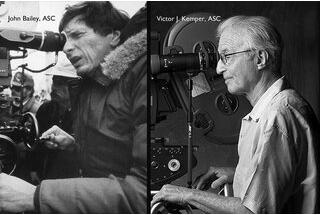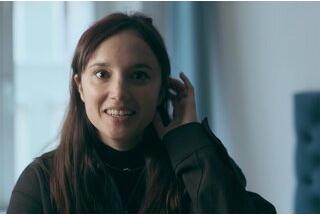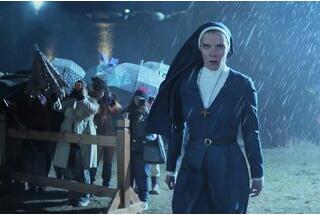Peter Deming, ASC, speaks about the shooting of "The Good Lord Bird", by Albert Hughes
Gunfights, Bible and DaguerreotypesAlbert Hughes (who directed Menace II Society, with his twin brother Allen) directed the pilot, while Peter Deming, ASC (Lost Highway, Mulholland Drive...) shot the seven episodes. He spoke with us about this film shot in Virginia, and which proposes a simultaneously modern and classic vision of a Western.(FR)
Mid-19th century. United States. Onion, a teenage slave, becomes an active member of the abolitionist activist group led by John Brown during "Bleeding Kansas", a bloody battle that turned this Midwestern state into a battleground between defenders and opponents of slavery. Although the notorious 1859 raid on the American armory at Harpers Ferry was not enough to set off the expected slave revolt, the event did spark the Civil War.
What makes a good western in your opinion?
Peter Deming: I don’t know if I consider myself to be a Western person... But in any case, those Albert Hugues and I discussed together were those by Sergio Leone. Albert is a big admirer of those films, and so am I. Westerns aren’t in fashion lately. The last ones that I can personally remember having seen in theatres are from the 80s and 90s... Silverado, for example, or Wyatt Earp, starring Kevin Costner. Very classic westerns, indeed…
How did you ensure continuity of style throughout the episodes?
PD: Albert is a very visual director. He wrote a "visual Bible’’, that recapitulated the main guidelines and references. This was as much for Showtime, as for the producers and the five different directors who were to succeed him. The visual style he established was generally followed, and I – because I was present throughout shooting of the entire series – tried to be one of its main keepers.
Did you have any particular visual references in mind?
PD: I remember that Ethan’s makeup artist, David Atherton, was in charge of aging and doing some tests while we were scouting... He sent us an iPhone picture of himself, with a false beard, treated with a "Daguerreotype" filter. We simply fell in love with that photo.
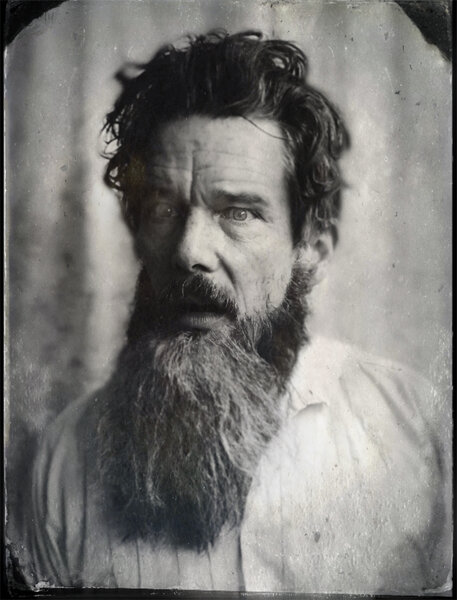
I think that if Albert and I had had carte blanche, we would have decided to shoot the whole show that way! But that would probably have been a little too extreme for the producers… and I totally understand that. So, we opted for a desaturation effect that tended towards that type of image, but which stayed more or less halfway to a black-and-white image that had suffered brown or cyan discoloration… And then we started looking for the lenses that would be best able to approximate that late 19th century look…
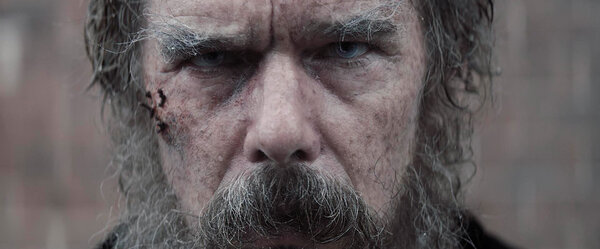
Tell me about those tools...
PD: We really wanted to make sure that those visual guidelines would be captured on set, and not just added in during color grading. We all know how difficult it is to keep control over the whole project from A to Z on a mini-series workflow…. Albert Hughes and I went to Panavision in LA to sift through Panavision’s storeroom of retro lenses. From amongst our precious finds, we selected the very old B series anamorphic lenses, and anamorphic Pathé lenses that I think Panavision picked up from MGM at some point... After dusting them off, Dan Sasaki and his team adapted them for wide format by adding a rear optical module to enable them to vertically cover the DXL2’s 8K sensor. I’d say we used those lenses to shoot nearly 90% of the series.
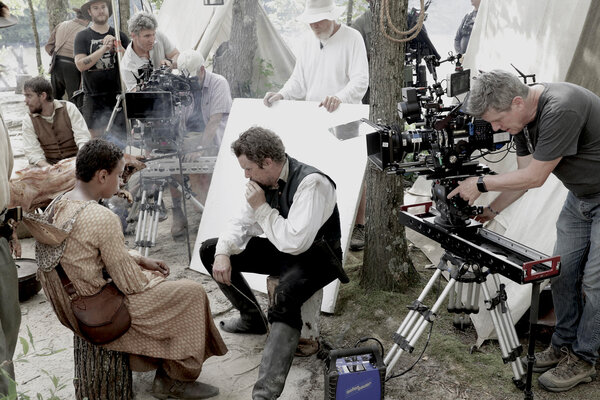
Okay, let’s talk about the color green. It’s not easy to shoot in the middle of summer in a forest, is it?
PD: Since we had decided to go with a desaturation of about 50%, that immediately toned down the greens. Besides the desaturation, we really wanted to show the dust, the lanterns, the costumes, the dirt… To take the opposite tack to the classic Western look, with sunsets on orange plains and spotlessly clean tents. Anyway, since most of the costumes and sets were either brown or in darker tones, apart from the red shirts that stick out from time to time, it’s really a world with very few colors……except of course the green of nature! Regarding the end result, and I’d like to return to what I said about our desire to obtain a daguerreotype look, I personally would have preferred to push the desaturation even further. That’s why I ask people I know to turn to adjust the settings on their television sets and reduce the colors halfway before they watch the show. I did it at home… and it works perfectly!
The opening sequence is a variation on the classic gunfight...
PD: We were filming in Virginia on location, on a big property owned by the State which is often used by productions. The idea was of course to keep Ethan Hawke in the dark until he got out of the barber’s chair. So we had lots of discussions about the ideal placement of this chair on the set, which turned out to be the place most protected from any light coming in from outside. For me, the challenge was how to keep details through the windows visible, given that it was so bright outside… and I didn’t really have a way to control what was going on outside.…So this is one of the rare scenes where I tried to emphasize the green color visible through the door and the windows, in order to avoid too much overexposure…
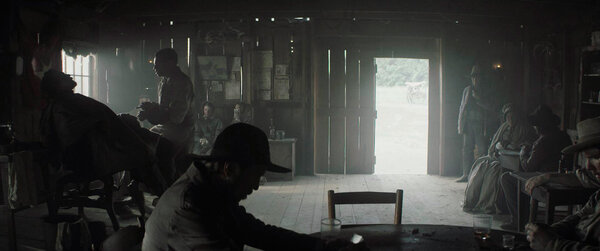
In terms of lighting, most of it came from outside: 18kW, 6kW Cinepar through the windows and the door. Indoors, one or two S30 or S60 Skypanels, and maybe a Litemat from Litegear… but very little fill. It was also a fairly static scene, with mostly still shots of actors who are hardly moving. As you say, a kind of duel in the main street… but transposed into this tavern.
Another nighttime campfire scene also reprises a great classic from cowboy films. But this time, the lighting gives the background a fantasy feeling.
PD : Those trees in the background were pretty weird. I don’t remember if it was because of a fire or simply because they had been trimmed… still they were very high, with few branches except at the top... They formed a rather unusual background for a forest. I opted for side lighting, because of the shape of the trees, and because there was no way logistically to place lights in the deep background.
There is a mysterious, almost dangerous feeling as the light falls off. It goes very well with this group of men, who are all wanted, and constantly in danger, as though they were engaged in a perpetual combat. By going for lighting that doesn’t show everything, it creates a sense of danger for the viewer because of the prospect of someone or something suddenly coming out from the woods…
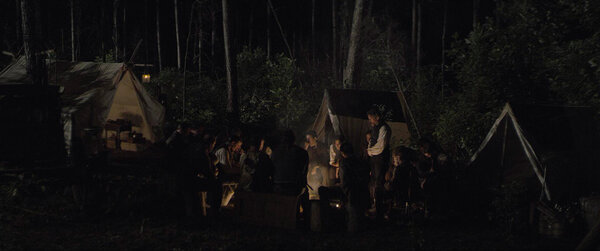
The reunion between Onion and Bob is a long master shot, like a breath in the middle of the chaos...
PD: This is the kind of thing that Albert Hughes likes to try from time to time. When you’re faced with a long dialogue like this one, attempting a single shot is sometimes more dynamic than simply cutting and traditionally covering the scene. It gives more energy, and it forces the actors to perform at a different pace. This was also shot about two weeks after filming had begun, and so we were starting to feel a little more confident in ourselves. And that’s also probably why Albert decided not to shoot this scene in any other way. It took us 5 or 6 takes if I remember correctly, and we shot it with a crane set up on a dolly, and a remote head. To manage the natural light, I had two diffusing silks stretched between the trees (directly, without frames) so as to soften the sunlight on the characters. As we wanted to show the heat and dust on the screen, the actors were regularly spritzed to appear sweaty. This helps to to get reflections on the skin, especially as in this scene the sun is in ¾ backlight.
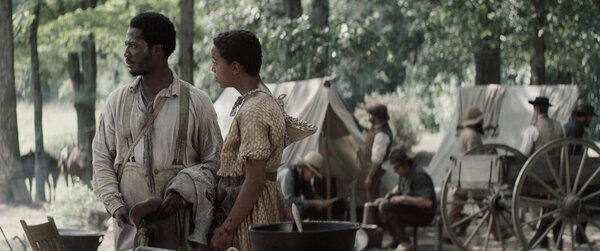
Frederick’s death scene includes a high angle crane shot, with an elliptical blur...
PD: Among the unusual lenses I told you about at Panavision, we also found a 40mm and 100mm anamorphic called “Portrait Lenses”. On these strange lenses, only the center is clear, everything else is in an artistic blur… As this is a rather strong effect, we decided to save them for only a few occasions in the series, such as the last scenes of a few episodes, or for emotional shots like Frederick’s death…
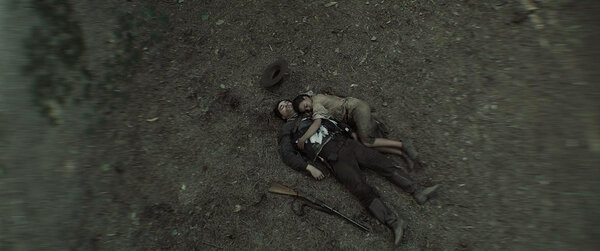
Any Shot you are particularly proud of?
PD: I personally like when Onion starts running in the middle of a gunfight, looking for John Brown, then starts talking with him while bullets are flying around theme very where… It might not sound like a big deal but the shot is at 96fps with Onion running very quickly across the field, so the camera was also moving very fast! It was shot on dolly tracks, with a Fischer 10 and a fluid head, stopping as Onion arrives next to John Brown. The slow motion ramping at 24 fps for the sync was of course done in postproduction. It wasn’t easy. I remember following the actor and suddenly stopping the camera as it was moving at almost full speed along the track!
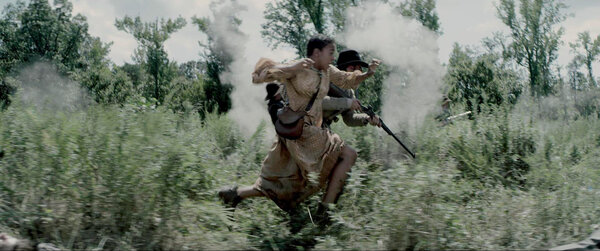
All of the camera movements on this series were made either with a dolly or a crane. Neither Steadicam nor gyro-stabilized system was used. It was really a 1930s or 1940s style setup!
What did you learn on this series?
PD: I would say that experience has shown me it’s easier to work with one or two directors on a limited series. Not that the successive directors lacked talent - they were all really very good! But, since they would show up in the middle of production and get updated about what had been done before them is obviously a handicap most of the time. On The Good Lord Bird Ethan often had the role of sherpa, either as an actor, or even by sometimes coming to the set on days when he wasn’t being filmed. This allowed him, for example, to point out to the director such and such thing that had been modified compared to the script in earlier sessions. This series was very important to him, and he is truly one of its main architects.
(Interview conducted by François Reumont for the AFC.)
The Good Lord Bird
Director: Albert Hugues (Pilot "Meet the Lord")
Director of Photography: Peter Deming, ASC
Production Designer: John Blackie
Costumes: Amy Andrews
Sound: Jay Meagher (Mixing)
Editing: Ron Rosen (Pilot "Meet the Lord")
Music: Jamison Hollister
Special Makeup Artist: David Atherton.
 En
En
 Fr
Fr
